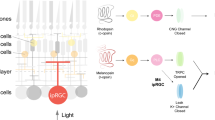Abstract
Optogenetic silencing using light-driven ion fluxes permits rapid and effective inhibition of neural activity. Using rodent hippocampal neurons, we found that silencing activity with a chloride pump can increase the probability of synaptically evoked spiking after photoactivation; this did not occur with a proton pump. This effect can be accounted for by changes to the GABAA receptor reversal potential and demonstrates an important difference between silencing strategies.


Similar content being viewed by others
References
Boyden, E.S., Zhang, F., Bamberg, E., Nagel, G. & Deisseroth, K. Nat. Neurosci. 8, 1263–1268 (2005).
Zhang, F. et al. Nature 446, 633–639 (2007).
Zemelman, B.V., Lee, G.A., Ng, M. & Miesenböck, G. Neuron 33, 15–22 (2002).
Gradinaru, V. et al. J. Neurosci. 27, 14231–14238 (2007).
Fenno, L., Yizhar, O. & Deisseroth, K. Annu. Rev. Neurosci. 34, 389–412 (2011).
Tønnesen, J., Sørensen, A.T., Deisseroth, K., Lundberg, C. & Kokaia, M. Proc. Natl. Acad. Sci. USA 106, 12162–12167 (2009).
Gourine, A.V. et al. Science 329, 571–575 (2010).
Han, X. & Boyden, E.S. PLoS ONE 2, e299 (2007).
Chow, B.Y. et al. Nature 463, 98–102 (2010).
Mattis, J. et al. Nat. Methods 9, 159–172 (2012).
Gradinaru, V. et al. Cell 141, 154–165 (2010).
Madisen, L. et al. Nat. Neurosci. 15, 793–802 (2012).
Staley, K.J. & Proctor, W.R. J. Physiol. (Lond.) 519, 693–712 (1999).
Wright, R., Raimondo, J.V. & Akerman, C.J. Neural Plast. 2011, 728395 (2011).
Chesler, M. Physiol. Rev. 83, 1183–1221 (2003).
Stoppini, L., Buchs, P.A. & Muller, D. J. Neurosci. Methods 37, 173–182 (1991).
Tyzio, R., Holmes, G.L., Ben-Ari, Y. & Khazipov, R. Epilepsia 48, 96–105 (2007).
Streit, P., Thompson, S.M. & Gähwiler, B.H. Eur. J. Neurosci. 1, 603–615 (1989).
De Simoni, A., Griesinger, C.B. & Edwards, F.A. J. Physiol. (Lond.) 550, 135–147 (2003).
Olsen, S.R., Bortone, D.S., Adesnik, H. & Scanziani, M. Nature 483, 47–52 (2012).
Cardin, J.A. J. Physiol. Paris published online: doi:10.1016/j.jphysparis.2011.09.005 (19 September 2011).
Hartmann, A.M. & Nothwang, H.G. BMC Res. Notes 4, 526 (2011).
Pouille, F. & Scanziani, M. Science 293, 1159–1163 (2001).
Ascoli, G.A., Gasparini, S., Medinilla, V. & Migliore, M. J. Neurosci. 30, 6434–6442 (2010).
Jin, X., Huguenard, J.R. & Prince, D.A. J. Neurophysiol. 93, 2117–2126 (2005).
Acknowledgements
We thank P. Bolam (Oxford University) for resources, and K. Deisseroth (Stanford University) and E. Boyden (Massachusetts Institute of Technology) for DNA constructs. We also thank G. Miesenböck, D. Kätzel and B. Richards for comments. Supported by a grant from the Medical Research Council (G0601503); research leading to these results received funding under the European Community's Seventh Framework Programme (FP7/2007-2013).
Author information
Authors and Affiliations
Contributions
J.V.R. and C.J.A. designed the research. J.V.R., T.J.E. and L.K. performed the experiments. J.V.R. and C.J.A. analyzed the data. J.V.R. and C.J.A. wrote the paper.
Corresponding author
Ethics declarations
Competing interests
The authors declare no competing financial interests.
Supplementary information
Supplementary Text and Figures
Supplementary Figures 1–7 (PDF 3640 kb)
Rights and permissions
About this article
Cite this article
Raimondo, J., Kay, L., Ellender, T. et al. Optogenetic silencing strategies differ in their effects on inhibitory synaptic transmission. Nat Neurosci 15, 1102–1104 (2012). https://doi.org/10.1038/nn.3143
Received:
Accepted:
Published:
Issue Date:
DOI: https://doi.org/10.1038/nn.3143
- Springer Nature America, Inc.
This article is cited by
-
Advanced neurobiological tools to interrogate metabolism
Nature Reviews Endocrinology (2023)
-
Intracellular chloride regulation mediates local sleep pressure in the cortex
Nature Neuroscience (2023)
-
Long-term in vivo application of a potassium channel-based optogenetic silencer in the healthy and epileptic mouse hippocampus
BMC Biology (2022)
-
Aion is a bistable anion-conducting channelrhodopsin that provides temporally extended and reversible neuronal silencing
Communications Biology (2022)
-
Multichannel optogenetics combined with laminar recordings for ultra-controlled neuronal interrogation
Nature Communications (2022)





